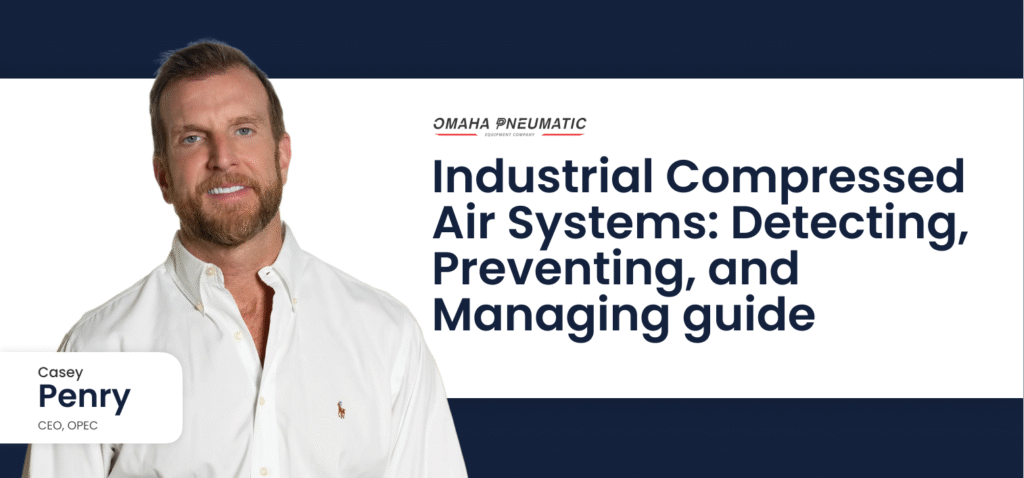Compressed air systems are the backbone of many industries. They power tools, run machinery, and keep operations running smoothly. But here’s the kicker: compressed air leaks are a silent drain on energy, money, and productivity. A single, tiny leak might not seem like a big deal—but over time, it adds up to massive waste.
In this guide, I’ll walk you through everything you need to know about detecting, preventing, and managing compressed air leaks. By the end, you’ll be equipped to tackle leaks head-on and keep your system running efficiently.
Why Compressed Air Leaks Are a Problem
1. Energy Waste
Did you know that leaks can waste up to 30% of your compressed air system’s output? That’s like paying for a full tank of gas and watching a third of it drip onto the ground. It’s an invisible thief stealing energy—and your money.
2. Impact on Operations
Leaks lower the efficiency of your system, which means your tools and machinery don’t perform as well as they should. This slows down production and makes your team work harder for the same results.
3. Financial Costs
Here’s the hard truth: fixing leaks is almost always cheaper than ignoring them. The cost of wasted energy, damaged equipment, and lost productivity far outweighs the expense of repairs.
How to Detect Compressed Air Leaks
Finding leaks doesn’t have to be rocket science. Here are a few tried-and-true methods to track them down:
1. Listening for Leaks
In a quiet environment, you can often hear hissing sounds where air is escaping. It’s not the most precise method, but it works for obvious leaks.
2. Soap Solution
Mix up some soapy water, apply it to connections and fittings, and look for bubbles. It’s simple, effective, and cheap.
3. Ultrasonic Detectors
For hidden leaks, ultrasonic detectors are game-changers. These devices pick up high-frequency sounds from escaping air, even in noisy environments.
4. Pressure Drop Monitoring
Turn off your system and monitor the pressure. If it drops when the system is idle, you likely have a leak.
Common Causes of Compressed Air Leaks
Understanding where leaks come from is half the battle. Here are the usual suspects:
1. Worn-Out Connections
Loose fittings, old seals, and worn-out gaskets are some of the most common sources of leaks.
2. Cracked Hoses and Pipes
Vibration, heat, and general wear can cause cracks in your air lines over time.
3. Faulty Valves
Valves that don’t close properly allow air to escape continuously, wasting energy.
4. Leaks in Tools or Machinery
Check your tools and equipment. Leaks often occur at connection points or within the tools themselves.
Preventing Compressed Air Leaks
Prevention is always better than repair. Here’s how you can minimize leaks in your system:
1. Regular Inspections
Make it a habit to check your system for leaks. A quick inspection can save you a lot of trouble down the line.
2. Use Quality Materials
Invest in high-quality fittings, seals, and pipes. They’re less likely to wear out or fail under pressure.
3. Train Your Team
Teach your employees to recognize the signs of leaks and report them immediately. Leak prevention is a team effort.
4. Optimize System Design
Fewer joints and connections mean fewer opportunities for leaks. Design your system to minimize weak points.
Fixing Leaks and Managing the System
Once you’ve detected a leak, it’s time to fix the leak fast.
1. Repair Leaks Quickly
Delaying repairs only increases the damage. Fix leaks as soon as you find them to save energy and prevent further issues.
2. Maintain Your Equipment
Regular maintenance keeps your system in top shape and reduces the likelihood of leaks. Check hoses, fittings, and valves regularly.
3. Use Monitoring Tools
Pressure regulators and flow meters help you keep tabs on your system’s performance. They can alert you to potential issues before they become big problems.
4. Shut Off Unused Equipment
When equipment isn’t in use, turn off the air supply. This simple step prevents unnecessary waste.
Reducing Overall Energy Costs
Here are some bonus tips to cut down on energy waste:
1. Pressure Optimization
Run your system at the lowest pressure required for the job. Over-pressurizing wastes energy and wears out your equipment faster.
2. Avoid Wasteful Practices
Don’t use compressed air for tasks like cleaning surfaces. It’s expensive and inefficient—there are better tools for the job.
3. Heat Recovery
Compressed air systems generate heat. Capture and reuse that heat for other applications, like warming your workspace or water.
Benefits of Leak Detection and Prevention
Let’s talk about why all this effort is worth it:
- Lower Energy Bills: Fixing leaks leads to immediate savings on your utility bills.
- Improved System Performance: A leak-free system runs smoother, works better, and lasts longer.
- Environmental Impact: Reducing energy waste helps you lower your carbon footprint.
- Workplace Safety: Eliminating leaks reduces noise levels and improves overall safety.
Final Tips and Long-Term Maintenance
Here’s how to keep your system in top shape for the long haul:
- Create a Maintenance Schedule: Regular checks and servicing prevent problems before they start.
- Keep Records: Document all inspections and repairs to track your system’s health.
- Invest in Technology: Modern tools and software can monitor your system in real-time, catching leaks early.
- Encourage a Team Effort: Make leak prevention everyone’s responsibility. A proactive team is your best defense against leaks.
Conclusion
Compressed air leaks might seem small, but their impact on your system and your bottom line is huge. By detecting, preventing, and managing leaks, you can save energy, reduce costs, and keep your operations running smoothly.
Don’t wait for leaks to drain your resources. Start inspecting, repairing, and optimizing your system today. Your tools, your team, and your budget will thank you for it!




